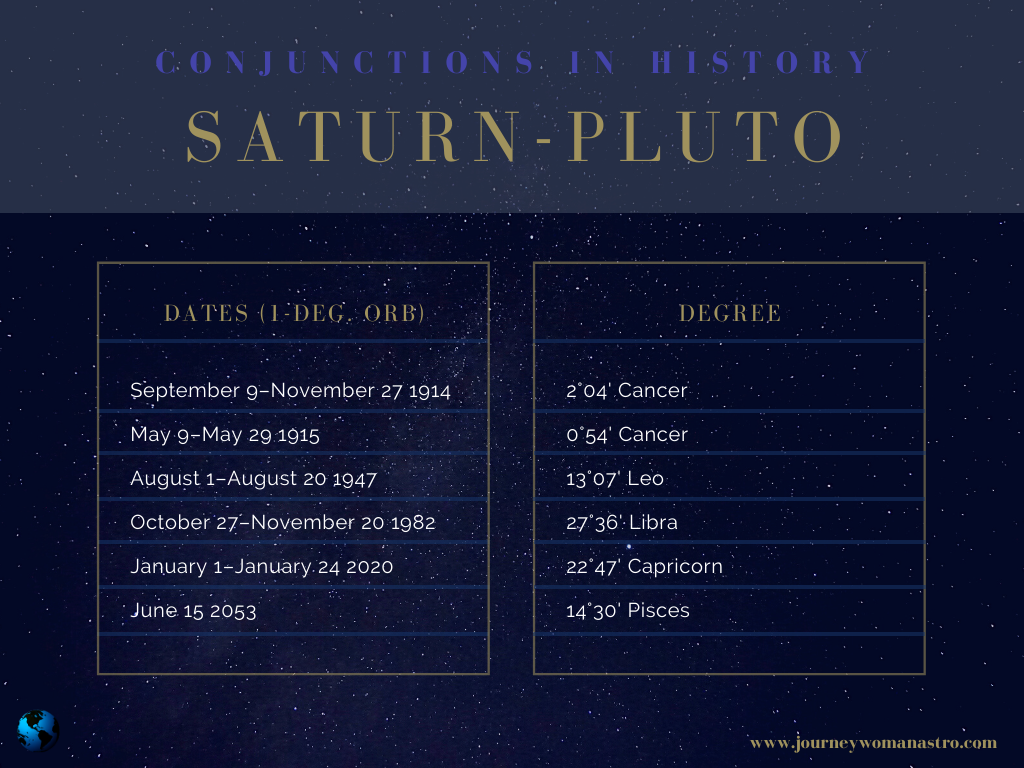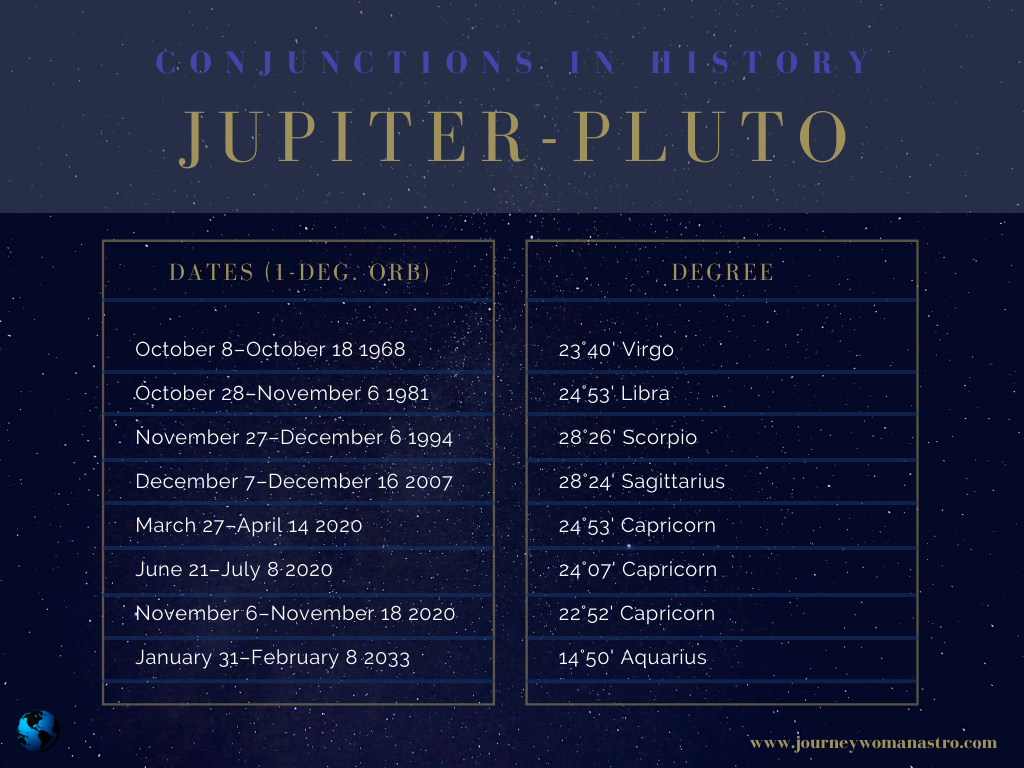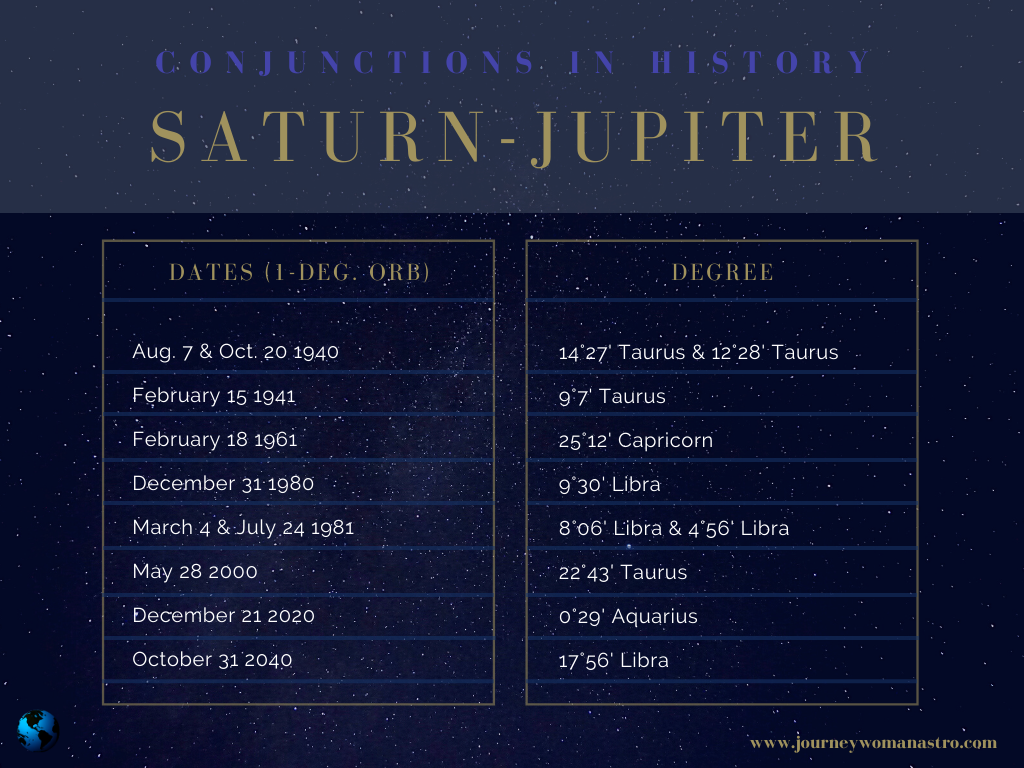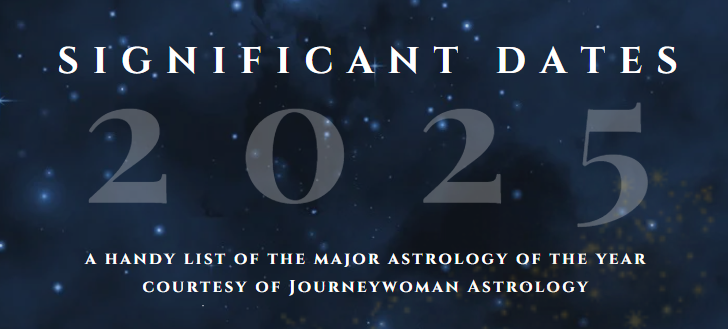Why are astrologers making such a big deal about this year? A look at the astrology of 2020, along with a guide to understanding what the historic Saturn, Pluto, and Jupiter conjunctions this year mean for you.
Table of Contents
The historic astrology of 2020
Astrologers have been eyeing the astrology of 2020 for years. Conjunctions of Saturn, Jupiter, and Pluto are rare—era-, even epoch-defining events. This year sees several of them.
On a worldwide level—in what’s called mundane astrology—these are ominous transits. There’s no denying it. No doubt, we’re currently experiencing their effects. But despite the continuing likelihood of world-historical events this year and next, these conjunctions do not necessarily have to bring challenges to personal lives. In fact, they can even accompany changes of the most positive variety.
While it’s definitely not helpful to minimize what we’re collectively going through right now, this year’s astrology does not need to represent unmitigated gloom. Precisely because we’re all experiencing collective stress in such significant, world-changing ways, it may be important to point to some of the positive possibilities inherent in the transits this year. It might be time for some more hopeful news.
In this post, I’ll share an overview of the conjunctions occurring this year. We’ll also look at a few examples from people on the rise in the early 1980s—the last time Saturn and Pluto met up—and then turn to what the conjunctions suggest for each of us this year.
For tips about how to interpret this year’s conjunctions in relation to individual birth charts, skip to this section. For more about the Saturn-Pluto-Jupiter conjunctions in history, read on.
Talk about understanding the historic astrology of 2020, and one book comes immediately to mind: Richard Tarnas’s Cosmos and Psyche, which seems to be on every astrologer’s reading (or re-reading) list right now. The book, which took Tarnas 10 years to write, correlates astrological cycles with major events in world history. (It’s a fascinating read.)
In his wide-ranging survey, Tarnas found that world events use wider orbs than we generally use in personal astrology. For example, while a personal transit of Saturn or Pluto to an individual’s birth chart will be most apparent within 1 degree from an exact orb, in mundane astrology, a 2-degree orb is considered virtually exact. Tarnas observes the influence of aspects in history at as much as 10- to 15-degree orbs.
Periods when Saturn and Pluto meet up in hard-aspect alignments (the conjunction, opposition, and square) are always significant, Tarnas has persuasively found. The most recent Saturn-Pluto hard aspect prior to 2020—the opposition—was exact in August 2001. Here’s Tarnas on 9/11:
“Within moments of the attacks on the World Trade Center, virtually every astrologer in the country knew that the forces symbolized by the Saturn-Pluto alignment, an alignment that had coincided in the past with so many grim periods of historical crisis and contraction, had erupted.” (Cosmos and Psyche, 210).
Similarly, every serious astrologer knew dramatic, history-making events were likely this year, no matter the New York Times’ inept reporting—though the paper reports it’s a Virgo (unsurprisingly!), the sign’s famous accuracy apparently eludes the paper in the case of astrology.
Of course, the events of this year have so far borne that concern out. The first major conjunction of 2020, between Saturn and Pluto, occurred on January 12. In early January, Twitter briefly lit up with the hashtag #WWIII when a Trump-ordered U.S. airstrike killed an Iranian military leader. That turned out to be a momentary altercation—though a foreboding one.
In actuality, the first warnings about a coming worldwide pandemic had already arrived. On January 11, just one day before the Saturn-Pluto conjunction was exact, China reported its first death from what was then being called a “novel coronavirus.” When Mars and Jupiter moved into the mix of that conjunction, in mid-March, the worldwide coronavirus lockdown took hold.
In the midst of the pandemic, we’re also now seeing a historic movement for social justice in response to police brutality toward people of color. The overwhelming trauma of police killings—now repeatedly caught on video—combined with the pandemic and its disproportionate effects on communities of color have created what one Howard University researcher calls a “perfect storm.” This social movement has already made history, with undoubtedly far-reaching changes to come.
The Saturn-Pluto conjunction in history and 2020
In the 20th century, hard aspects between Saturn and Pluto have been particularly significant.
The first conjunction in the 20th century coincided with the start of World War I. Saturn and Pluto were 7 degrees apart on June 28, 1914, when Austro-Hungarian Archduke Franz Ferdinand and his wife were assassinated—an event that sparked the subsequent war. By the time the conjunction was exact, in October and November of that year, the two sides of the war had taken shape, with the Allied Forces (France, Italy, Great Britain, Japan, and Russia) united against the Central Powers (Germany, Austria-Hungary, and Turkey).
The subsequent Saturn-Pluto square coincided with the beginning of World War II, which began when Hitler invaded Poland on September 1, 1939. At the time, Saturn and Pluto were in a square alignment at just over 1 degree.
While the Saturn-Pluto conjunction is never exactly easy, it does not always indicate catastrophic events. The conjunction does, however, tend to coincide with shifts in power and periods of contraction and limitation. The second Saturn-Pluto conjunction of the 20th century occurred in 1947, coinciding with the start of the Cold War, the founding of Israel, and the partition of Pakistan and India—each the birth of long-standing tensions that continue in some form to this day.
The most recent Saturn-Pluto conjunction, in November 1982, occurred shortly after the election of Ronald Reagan in the United States and Margaret Thatcher in the United Kingdom—an epochal shift in that the rise to power of these two figures heralded a conservative backlash against the civil rights, feminist, and anti-war movements of the 1960s and 70s. Reagan and Thatcher’s attacks on social programs and the influence of trade unions ended an era of longstanding economic stability that had persisted since the end of World War II—contributing, ironically, to the rise of women in the workplace, since it also resulted in the end of the previously feasible one-income household. (For a look at that conjunction in Reagan and Thatcher’s charts, see below.)
Interestingly, Tarnas suggests the discovery of Pluto, in 1930—falling as it did between the two world wars—heightened the effects of the hard-aspect Saturn-Pluto alignments in the first half of the 20th century. This year, Jupiter joined the conjunction, heightening its effects by globalizing it.
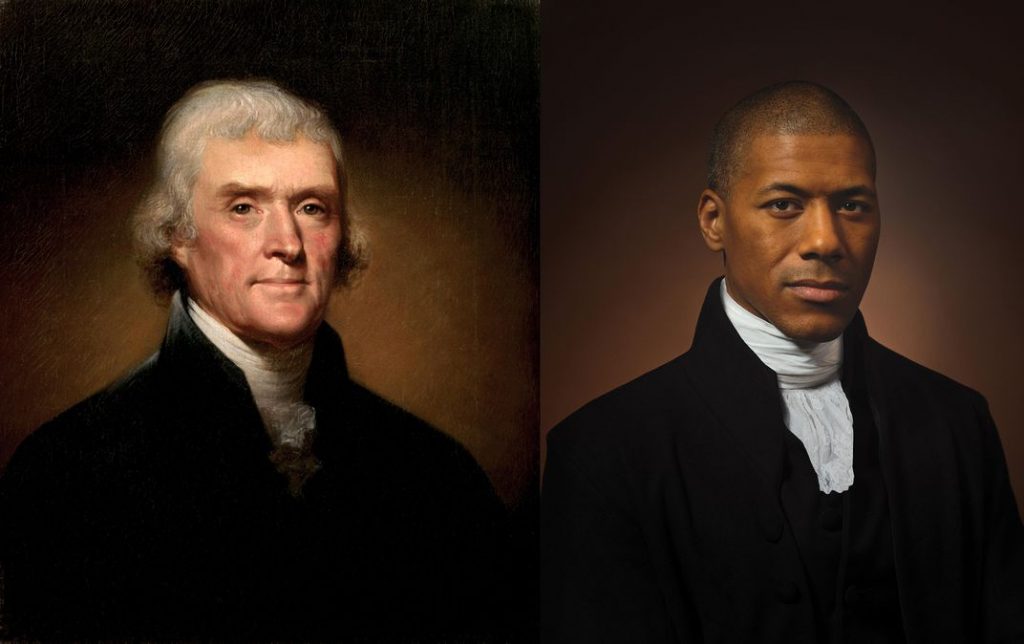
How about 2020?
With this conjunction, Saturn, planet of discipline, structure, authority, tradition, and the patriarchy, is butting heads with Pluto, the planet of power, wealth, and profound, transformative change. After a long period of Saturn and Pluto transiting Capricorn— a sign ruled by Saturn that is also representative of structure, authority, and the patriarchy—with this year’s conjunction, it may be that authority itself will be forced to change. We now see Republicans in the United States floundering in the face of a pandemic that demands collective social action on behalf of global public health. Yet, traditionally (pun intended, I suppose), conservatives—who prefer to focus on individual freedoms—have had a hard time acknowledging the concept of community: instead, they tend to think, as Margaret Thatcher famously claimed, “there is no such thing as society.”
Republican leadership response in the face of the Black Lives Matter movement has been similarly myopic, if not race-baiting—fanning the flames rather than responding to what are severe, long-standing concerns. Yet we’re also seeing significant shifts, as the Minneapolis City Council votes to defund its police force and overwhelming public opinion currently supports similar moves across the U.S. along with the Black Lives Matter movement itself. I believe we’ll continue to see clashes around these issues this year and in the years to come, particularly as Uranus moves to square Saturn in the sky next year.
Other standout examples of Saturn-Pluto hard aspects in history: the fall of Rome, the bubonic plague. The early 80s Saturn-Pluto conjunction, in addition, saw the beginning of the AIDS epidemic, echoing this year’s pandemic and highlighting Saturn-Pluto themes of deprivation, mortality, security. With Saturn-Pluto alignments, there may be a sense of “no turning back”—an end to an era of innocence that can rarely be reclaimed.
Saturn conjoins Pluto roughly every 33 to 38 years. This year’s Saturn-Pluto conjunction starts what’s called a new synodic cycle, meaning that what happens now, as in previous conjunctions of these two planets, will influence the next 30-some years. The next Saturn-Pluto square will occur in 2028, the opposition will happen in 2036, and the next conjunction will occur in 2053.
Born with a Saturn-Pluto conjunction:
George Eliot, Gustave Courbet, José Ortega y Gasset, Les Paul, Orson Welles, Victoria Queen of England, Temple Grandin, Steve Forbes, Al Gore, Carlos Santana
The Jupiter-Pluto conjunction in history and 2020
Jupiter conjoins Pluto every 13 years. This particular conjunction doesn’t last long, because Jupiter moves quickly. Yet that doesn’t necessarily lessen the impact of these two heavy-weight planets, which, when combined, focus on great power, great wealth, and profound transformation.
The first of this year’s three Jupiter-Pluto conjunctions occurred in mid-March to early April, at the start of the Covid-19 lockdown. As a result of both planets’ retrogrades, the second conjunction happened in early July, as Covid-19 cases are again surging in the United States.
Jupiter and Pluto will return to a final conjunction just after the U.S. election in November. Regardless of the outcome of the election, a Jupiter-Pluto conjunction at such a tense, pivotal time in American politics is likely to reflect the prevailing mood: we may see shifts in power, power plays, and continued widespread insistence on issues of social justice. Given Covid-19’s connection to the first two Jupiter-Pluto conjunctions this year, we may see another resurgence of the virus at that time as well.
Other notable events that have occurred at the time of Jupiter-Pluto conjunctions: the start of the global financial crisis in December 2007; and, at a key moment during the civil rights movement in October 1968, athletes John Carlos and Tommie Smith were expelled from the Olympic Games after giving the Black Power salute on the winners’ podium. Fittingly, in July 2008—just as Pluto and Jupiter left another conjunction—both were honored with the Arthur Ashe Courage Award.
The next Jupiter-Pluto square will occur in May 2023, the next opposition in 2026, and the next conjunction in 2033.
Born with a Jupiter-Pluto conjunction:
Geena Davis, Jean-Luc Godard, Lawrence Ferlinghetti, Céline, Louis Braille, Maria Shriver, Nat King Cole, Niki de Saint Phalle, Whoopi Goldberg
The Saturn-Jupiter conjunction in history and 2020
Jupiter conjoins Saturn (a “great conjunction”) every 20 years. This conjunction combines the exuberance of Jupiter with the caution and discipline of Saturn. Opposing influences, in this case, can make for powerful energy for getting things accomplished—perhaps why many high achievers have this conjunction natally.
At this year’s Jupiter-Saturn conjunction on December 21, we’ll see the year’s final significant infusion of planetary energy. Saturn and Jupiter are not always friends: Saturn is too stodgy for enthusiastic, optimistic Jupiter, while high-flying Jupiter makes security-conscious Saturn nervous. Together, though, these energies can make a wise pair, especially for new starts: we can be grounded and disciplined (Saturn) as well as hopeful and energetic (Jupiter). Less positively, however, Saturn can act as a brake, dampening Jupiter’s optimism and drive.
This conjunction represents yet another major shift in a year already full of them. As of December, Saturn and Jupiter will meet in air signs for about the next 200 years. For the last 200 years, Jupiter and Saturn have met in earth signs (with just one exception, in 1981, when they met in Libra). This shift in element heralds a period the Jetsons—or Orwell—might have envisioned: what is likely to be continued growth in the power of ideas and technology, along with, perhaps, continued great wealth combined with intrusive authority and income inequality. More positively, this new focus in air signs could represent humanity employing technology to solve the many urgent problems threatening our planet.
Born with a Saturn-Jupiter conjunction:
Alex Haley, Bruce Lee, Chuck Close, Dick Cheney, Esther Williams, Faye Dunaway, Gene Roddenberry, Gustave Flaubert, Jake Gyllenhall, Jessica Alba, Joan Baez, Joseph Gordon-Levitt, Justin Timberlake, Meghan Markle, Natassja Kinski, Neil Diamond, Nick Nolte, Pelé, Raquel Welch, Richard Pryor, Sam Waterston, Saul Kripke, Werner Heisenberg
Table of Contents
Examples in personal charts:
Hits from the '80s
This year’s astrology has been accompanied by lots of anxiety, if not fear-mongering, among astrologers. Even the most optimistic among us have been worried—with good reason, as we now see on a mundane level.
The negative expressions of the outer planets, perhaps unfairly, tend to get a lot more press than the positive changes they may also accompany. Yet a look at these transits in the context of individual lives shows they can also bring changes of, in fact, the most positive kinds. Want proof? Let’s check out a few throwback examples from the 80s.
Madonna: Star light, star bright
A self-proclaimed “maverick”—which later became the name of her label, Maverick Records—Madonna produced countless imitators, changing pop music forever. She moved to New York in 1978, where she formed her first bands and started performing. In mid-1982, she had a fateful meeting with legendary Sire Records founder Seymour Stein, who signed her to his label from a hospital bed after hearing her demo earlier that day. (He didn’t summon her, though—she had invited herself: “Madonna had bigger balls than the four men in the room put together,” Stein wrote in his recent autobiography.)
Her transits reflected the powerhouse career she would soon embark on: the Saturn-Pluto conjunction of November 1982 conjoined her natal Jupiter at just under a degree, providing a tremendous boost to her natural drive. “Everybody,” “Burning Up,” and “Holiday,” her first three singles—released in late 1982 and 1983—were hits, launching her to immediate fame and power.
Madonna’s birth chart, on the left; a biwheel of her chart with the November 1982 Saturn-Pluto conjunction, right. Click to expand.
Quincy Jones: Ascendant to power
Quincy Jones is another towering figure of the 80s who benefited from the Saturn-Pluto meetup. In November 1982, the Saturn-Pluto conjunction conjoined his Ascendant, as Lynn Bell has pointed out, at just a half-degree orb. At the time, he was producing Michael Jackson, whose album Thriller—released on November 30, 1982—went on to become the best-selling album worldwide of all time. His work with Jackson made him the most powerful music producer in the business.
Annie Lennox: Dreams are made of this
For Annie Lennox, the 1982 Saturn-Pluto conjunction happened on her Neptune (19-minute orb), while it exactly squared her natal Jupiter (1-minute orb) and sextiled her Pluto. It also closely semisextiled her Pallas—an asteroid that suggests wise strategy in the chart—and squared her Chiron.
In 1981, Lennox and Dave Palmer—the two had recently formed the Eurythmics—got a bank loan to create their own recording studio in a London factory. The first few singles they released were not a success, and it looked as if the loan might be at risk. She must have been quite on edge: Saturn-Pluto squaring her natal Chiron suggests this was a painful time, yet those two heavyweights may also have given her the belief in herself to continue despite her fears.
Then, in January 1983—three months after the Saturn-Pluto conjunction conjoined Lennox’s natal Neptune—the band struck gold (and platinum) with the release of the album Sweet Dreams (Are Made of This). The single from the album launched the band and both bandmates’ subsequent careers. Saturn-Pluto squaring Lennox’s natal Chiron and Jupiter shows the significant, initially difficult risk she took—but then, joining up with Neptune, the planet of glamor and fame, the conjunction made her famous.
Bruce Springsteen: Rough road to success
Springsteen has a slightly different story: Saturn and Pluto were transiting his packed 5th house in the early 80s. Springsteen has a 4th-house Sun right on the cusp of his 5th house (at under a degree). Meanwhile, Ceres, Neptune, the South Node, Mercury, the Moon, and his Scorpio Venus all fall in his Libran 5th house.
This remarkably creative stellium was hard-hit by Saturn and Pluto, as well as buoyed by Jupiter, in the early 80s. In late 1980, Saturn and Jupiter crossed his Sun and moved into his 5th house just as he released the crowd-pleasing double album The River. On September 30, 1982, Springsteen then released the somber Nebraska, which he’d recorded in January of that year. He was depressed while writing it, according to a biographer—understandably, with Saturn and Pluto dimming the lights in his chart around this time. Just a year before, in October 1981, Pluto had passed over his Moon. In October 1982, Saturn then passed his Moon. Springsteen chose not to tour in support of Nebraska, but the album was a huge critical success—named album of the year by Rolling Stone. Finally, in June 1984, Born in the USA, his often-misunderstood chart-topper, was released. Saturn would leave his 5th house just a few months later.
As Saturn, Jupiter, and Pluto moved through his 5th house, transforming, expanding, and deepening his creative output, Springsteen produced some of his most profound work and created a now-legendary catalog. His career would only rarely return to such songwriting heights (see The Ghost of Tom Joad, released in 1995 as Pluto squared his Midheaven).
Reagan and Thatcher: The Iron Lady and transformed actor
As the Saturn-Pluto conjunction of 1982 changed global politics, it also affected the lives of world leaders. President Ronald Reagan, elected in November 1980, was no exception. On March 30, 1981, Reagan survived an assassination attempt: at the time, Saturn and Jupiter were transiting his 10th house. At just over a degree apart, they were also squaring his natal Mars.
Like Lennox, this is another example of how these conjunctions can have multiple effects depending on how they aspect a natal chart. For Reagan, the Saturn-Jupiter square to natal Mars meant some kind of stumbling block was possible, but as the heavyweights moved through his house of work and status, supporting his rise to the role of world leader, they were also sextiling his Ascendant—lending their gravitas to help change his public image (the Ascendant) from lightweight Hollywood actor to global leader.
Margaret Thatcher is another figure inevitably associated with the rise of conservatism. In the early 80s, Saturn and Pluto made dramatic aspects to her chart, supporting her transformation to the “Iron Lady” of England (a very Saturn-Pluto moniker).
Thatcher was elected prime minister in May 1979. By October of that year, Pluto—the planet of wealth and power—had moved to conjoin her Sun. It returned to her Sun from April through September of 1980. After Pluto had effected its powerful transformation of her personality (the Sun), Saturn helped sealed the deal, conjoining her Sun in December 1981 and twice more in 1982. Both planets also passed over her natal Mercury during the same period.
Meanwhile, Jupiter also moved over those 11th house planets in 1981, adding a surge of expansion and energy to the dramatic increase in power she was already experiencing. By the time of the Saturn-Pluto conjunction in 1982, Jupiter had just passed her Ascendant and moved into her 1st house, giving her great energy to tackle transforming Britain—for better or worse.
Table of Contents
So where is all this in your chart?
In individual lives, what matters most is where these transiting conjunctions fall in your personal chart. Are they conjoining or aspecting your natal planets, angles, Sun, or Moon? If so, you’re likely to feel their effects more strongly.
If the conjunctions are positively aspecting a significant point in your chart (trining or sextiling), expect to have significant planetary support for your goals and projects this year. If they’re conjoining, squaring, or opposing a point in your chart, the influences can go either way.
The “at a glance” guides to Jupiter, Saturn, and Pluto in this section will help you parse these planets’ influence and energy.
If you have the opportunity, the best way to use this year’s energy is by steadfastly working on a major change, or putting to rest themes from 1982 or 2001—or both.
Here’s how to find where the transits and conjunctions of 2020 fall in your chart, along with general guidelines for interpreting them.
- If you don’t have your birth chart, I recommend Astro.com. (For tips about how to pull up your chart there, see this post.)
- Next, find where the late degrees of Capricorn (22 to 25 degrees) fall in your chart. Look for any planets or angles that fall at those degrees.
- Now check the image below for the degrees Jupiter, Saturn, and Pluto will travel through this year. Do you have the Sun, Moon, planets, or any angles between those degree ranges?
With this information in hand, you’re ready to delve deeper. Let’s dig in.
First, look to the house in your chart where Capricorn is on the cusp (the “starting line” of the house). This will tell you the areas of life that the conjunctions of this year are affecting for you. (You’ll find a guide to the houses in this post.) Here are a few more essential clues for interpreting this year’s conjunctions in your personal natal chart.
Orbs
I recommend a 1-degree orb for transits (yep, really, just 1 degree). I find a 1-degree orb is unerringly accurate in terms of timing significant events and changes.
Where the action is
If the conjunctions at roughly 22°-24° Cap fall within 1 degree of a planet or an angle in your chart, you’ll see the most action from the conjunctions this year.
You may get a pass
If Saturn, Pluto, and Jupiter are just mosey-ing along by themselves through your Capricorn house—without aspecting a planet or angle—this year should be less dramatic for you. Instead, this year’s conjunctions are likely to reflect changes that have been percolating for some time.
Jupiter at a glance
Jupiter keywords: Optimism, expansion, generosity, confidence, luck -♦- wealth, abundance, excess, extravagance, exaggeration, inflation -♦- higher education, law and the legal system, philosophy -♦- the big picture, traveling, adventuring
Event, crisis, or opportunity
As Saturn, Pluto, and Jupiter moved forward from January to March this year, then retrograde this summer, and finally station direct again this fall, they’ll aspect the same degree ranges in your chart three separate times. The exact timing of these “hits” will vary from person to person.
Evolution via retrograde
In general, the first exact “pass” of a planet introduces the event, crisis, or opportunity associated with its aspect. The second pass, by retrograde, will often see actions or activity slow: it may be time to reconsider, to retrace steps, to dig in for the long haul or retrench. The third and final pass, when the planet moves forward again, generally brings closure or some kind of conclusion to this cycle. Look for when Saturn, Jupiter, and Pluto move out of a 1-degree orb with planets, angles, or the “lights” in your personal chart to know when you’ll be out of the water and looking at new horizons after the conjunctions of this year.
Saturn-Pluto-Jupiter babies
If you were born with one of the conjunctions happening this year—that is, you have a conjunction of Saturn-Pluto, Pluto-Jupiter, or Saturn-Jupiter in your natal chart within about 8 degrees—this is more likely to be a significant year for you. Look to the aspects this year’s transiting conjunctions are making to your chart for clues about what will manifest, and how.
If you have an actual baby being born this year, take heart: while the year’s aspects will be generational (meaning everyone born this year has them), this year’s children may be uniquely equipped and positioned to tackle the grave, undoubtedly pressing problems our planet will face in the coming decades.
Pluto at a glance
Pluto keywords: profound transformation, growth, regeneration, evolution -♦- the immutable, the unavoidable, that which many prefer not to face—“sex, death, and taxes” -♦- deep and instinctive emotions, obsessions, the unconscious, the id, the underworld -♦- suspicion, compulsions, danger, persecution -♦- profound understandings, insight -♦- secrets, the hidden, taboos, the unspoken -♦- power, influence, wealth, fame
The astrology of 2020 by sign:
The quick guide
Here’s a guide to the astrology of 2020 by sign. In “cookbook” interpretations like these, I always emphasize that transits and aspects need to be interpreted in the context of your entire chart. Annie Lennox is a great example: the conjunction in the early 80s reflected both considerable stress as well as remarkable success in her life.
Capricorn—you may be seeing a burst of change during the conjunctions in your sign this year, especially if they aspect a planet or an angle in your chart. Still, that doesn’t necessarily mean you’re in for it (see those examples above). Remember that conjunctions can manifest in a wide range of ways, from difficult to empowering.
Cancer, Aries, Libra—the conjunctions this year will oppose the sign of Cancer, while they square Aries and Libra. Those with planets or angles in these three signs may see challenges this year, since these can be tense aspects. You could feel blocked, depressed, or frustrated, or you may be dealing with difficult, if not excruciating, circumstances. Again, though, there are lots of variations here: the conjunctions may, for example, square one planet in your chart, but make a supportive aspect to another planet or angle.
The signs of Capricorn, Cancer, Aries, and Libra may see the most challenges and—on the positive side—heightened growth, authority, or responsibility this year. Scorpio, Pisces, Taurus, and Virgo are most likely to be supported by this year’s conjunctions.
Scorpio, Pisces, Virgo, Taurus—those with planets or angles in these four signs are most likely to feel supported by the conjunctions this year, and they could mean good news or positive conditions in relation to the planet or angle they’re aspecting. For example, perhaps the Saturn-Pluto conjunction is sextiling your Midheaven. You could see significant beneficial changes in career or work responsibilities: perhaps you get a promotion you’ve been working on for years.
Lastly, take a look at where the earliest degrees of Aquarius fall in your chart: this will show you where the last conjunction of the year, the Saturn-Jupiter conjunction on December 21, will fall, as well as where Saturn and Jupiter are headed for you next year. Saturn was in the early degrees of Aquarius until July 1, when it moved back into Capricorn. It will return to Aquarius on December 17, post-retrograde. Jupiter enters Aquarius for good on December 19, while Pluto, the laggard, won’t move into Aquarius in March 2023.
Saturn at a glance
Saturn keywords: Discipline, persistence, endurance, stamina, diligence -♦- wisdom, maturity, adulting -♦- responsibility, restraint, caution -♦- restriction, depression, loneliness -♦- burdens, frustration -♦- awkwardness, insecurity, inhibition -♦- the shadow, internal critic, or Achilles heel -♦- structure, authority, patriarchy, conservatism -♦- wisdomkeepers, old age, time
Looking forward
How and in what ways the conjunctions this year accompany events in each of our lives has to do with a mysterious alchemy of fate, destiny, and free will. I’ve pointed out the positive possibilities inherent in this year’s transits to counterbalance the heavy challenges many of us are currently experiencing.
Yet it is also true that these transits can manifest in profoundly difficult ways in personal lives. Right now, there’s absolutely no shame in focusing on just getting by—please ignore the people suggesting we should learn a new language in quarantine or check off any boxes on our self-improvement to-do lists. You may feel like you’re between a rock and a hard place, stretched beyond your limits. Or you may be dealing with a past or current wound or trauma.
If you’re going through it this year, take all the time to rest and integrate you can. And know that this, too, shall pass—and, in fact, is likely to pass around the end of this year. In the meantime, we’ve all gotta do what’s necessary to survive. Suffering is never meaningless, appearances to the contrary. Know that you are being prepared for better things on the other side.
This year could also be profoundly transformative. As Tarnas said in a recent analysis, Saturn and Pluto can allow for
forging habits and structures that will endure. This is a time to do heavy lifting. What you put into place, what you work hard on, the hard labor right now in your life, can set up structures that will last for the rest of your life. Take the opportunity.
By the year-end holiday season, many of us will probably be more than ready for a break. Yet the end of the year should still be an important time of clarity—and as we turn the corner into the new year, we’re likely to be able to take off running out of the gate.
As Pluto moves through more retrogrades next year, we’ll see the powerful transformations coming out of the conjunctions of 2020 continue to echo. No doubt, we’ll each be settling into new self-understandings, new insights, new patterns and structures, that will have long-lasting and far-reaching impact.
Stay healthy, friends, and I wish you a year of growth, transformation, and safety during this historic year.
I’m offering sliding-scale consultations for those experiencing financial challenges this year—don’t hesitate to email for the private booking link if this applies to you. I also have a special on consultations looking specifically at the astrology of 2020.
What’s your Saturn-Pluto story this year? Have questions about how this year’s transits are affecting your chart? Let’s discuss in the comments.

